Running a Hybrid Event Is a Lot of Work — Here’s Why It’s Worth the Effort

Table of Contents
Maximize Your Marketing ROI
Join 10,000 other marketers already getting the best tips on running engaging events that boost pipeline and create raving fans.
Just a few years ago, digital events were largely a one-trick marketing format — suitable for webinars, small-scale internal meetings … and that’s about it.
But then, the pandemic. Practically overnight, event marketers were forced to rethink old formats and transform digital events into a robust marketing channel worthy of its own goals, resources, and budget.
As a community, B2B event marketers have come a long way since the days of ‘sit back and watch’ webinars, with interactive virtual summits, customer events, and VIP experiences fast becoming the rule rather than the exception.
But if there’s one area of the digital event marketing world that still feels like the wild west, it’s hybrid.
Hybrid events are no longer a thing of the future — they're here now. And according to our latest research, they're here to stay. But that doesn't mean we've nailed the formula.
As part of our ongoing mission to become the strongest hybrid partner for modern event marketers, we knew we had to get our hands dirty with hybrid. And we’ve come to realize, there is a whole lot more that goes into running a hybrid event than first meets the eye.
Today, we're peeling back the curtain on our own experience with hybrid events — because while we haven't aced the format just yet, we have learned a lot already.
Here’s what we’ll cover:
- What do we mean by ‘hybrid’ event?
- Why hybrid events are here to stay
- The challenges of hosting a hybrid event
- Making hybrid happen — what we've learned so far
What do we mean by ‘hybrid’ event?
First, let’s clear the air on what a hybrid event actually is.
One part virtual and one part in-person, hybrid events combine the digital benefits of an online meeting with the classic advantages of an in-person event.
Though the exact format for a hybrid event is still a work in progress for many brands (including our own), they typically take one of four forms:
- Standard hybrid: An in-person main stage plus live-streaming to an online audience with special programming for the audience at home.
- Virtual hybrid: With some of the event pre-recorded and a live in-person session every three tracks or so.
- In-person + virtual hybrid: A virtual conference on a platform like Goldcast, combined with streaming from an in-person venue and speakers appearing at both.
- The hybrid sandwich: Using the content created at your in-person event for your virtual event, alongside other engagement levers.
For the purpose of this article, we’ll be primarily focusing on the last two formats while drilling down on key lessons learned from our own hybrid roadshow, Event Marketers Live In Real Life (a.k.a. EML IRL).
Hybrid events are not live events live-streamed. The virtual audience needs more than to watch a camera feed of what’s going on in person.” — Reagan Hochmeister, Goldcast
Why hybrid events are here to stay
Our team recently surveyed over 500 business professionals who attended a work-related event in the last two years — both in-person and virtual-enabled.
We asked respondents for their candid opinions on what they want to see more and less of when it comes to digital events. Their resounding answer?
More. Hybrid. Events.
A majority 73% of business event attendees predict hybrid will become the most common event format in the coming years.
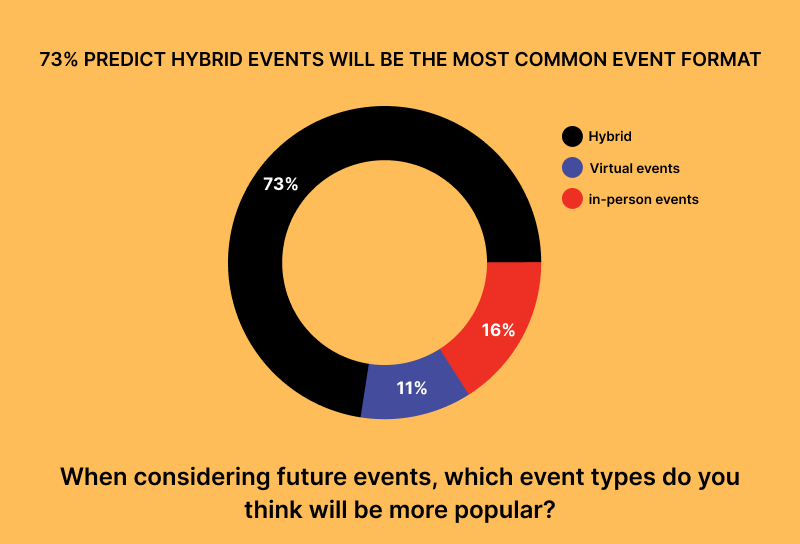
According the attendees, this is because hybrid events are more:
- Inclusive for people who can't make it in-person
- Flexible for those who have calendar conflicts
- Budget-friendly for both hosts and attendees
- Time-efficient, with no need for travel
- Accessible to those with diverse needs
- Engaging due to increased networking features and direct-to-speaker communication.
Our research also found that some 81% of attendees are more willing to sign up for hybrid and virtual events compared to in-person.
It’s worth noting that these benefits carry over to the event marketers themselves too.
In addition to broadening your reach and offering a more accessible event, hybrid events also provide:
- Increased attendee numbers due to their location-independent nature
- A broader range of attendees and customer personal
- The ability to cater to attendee preference for in-person or virtual
- Access to deeper event data
- Improved sales follow-ups
- Reduced budget and carbon footprint
With perks like this, you might be wondering what the downside is.
According to our research, the main drawback with hybrid is simply that it’s a lot harder to nail the delivery. In fact, only 11% of attendees rated their hybrid event experience ‘excellent’.
Clearly, we’ve got a long way to go before we’re ready to deliver on attendee expectations. The good news is, we’re getting there.
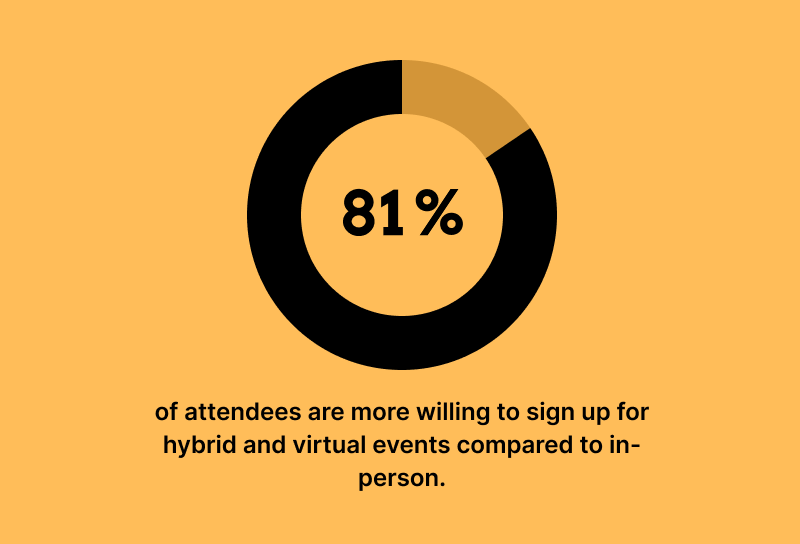
The thing about hybrid…
We’ll be honest, it’s easy to feel like you're facing double the work when it comes to planning a hybrid event.
Here’s a closer look at the three top challenges our own team came up against when planning our EML IRL event.
Challenge #1: Planning two events, not one
The pre-2020 hybrid event standards of simply live-streaming an in-person event as it plays out on your main stage are over. Going in, we knew this wouldn’t be enough to attract an audience of event marketers that had seen that trick so many times before.
To make our hybrid event stand out, we knew we were going to need to plan two distinct events — each with a different but equally engaging experience.
Of course, double the events means double the workload.
The first thing to get your head around with hybrid is that yes, it is more work. You’ll want to plan extra bandwidth and budget to get the best results.
Challenge #2: Creating an equally engaging experience virtually and in-person
Providing an equally high quality experience to both in-person and digital audiences is a big ask. After all, it’s always easier to wow audiences and facilitate organic conversations when everyone’s in the same room.
At Event Marketers Live In Real Life, attendees who joined the event in-person had access to happy hours and smaller think tank discussions that worked like a dream for networking and engagement.
Digitally, that was trickier to facilitate — but not impossible.
We used digital breakout rooms and a live DJ session to help create the same easy networking environment our Boston-based attendees had access to for our virtual attendees.
Though the in-session content experience was almost identical, there was some extra planning needed to help deliver the same feeling of connection to our virtual attendees.

DIGITAL BREAKOUT ROOM
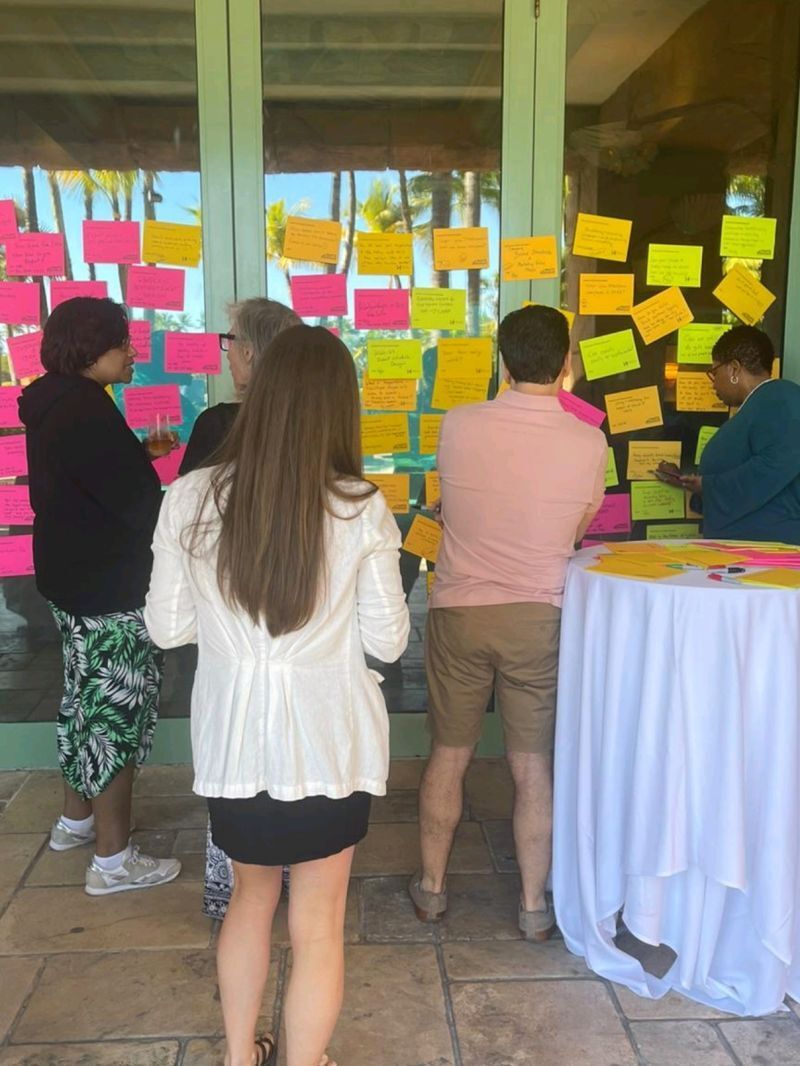
THINK TANK DISCUSSION FROM EML IRL
Challenge #3: Budgeting for both
Budget is always a factor.
With a growing number of attendees shying away from large expensive conferences in favor of targeted roadshows and digital events, this is another area where the cost benefits of hybrid are just waiting to be fully tapped.
Taking a look at our five key spend areas for EML IRL, we immediately knew that three of these areas would need their own dedicated budgets for virtual and in-person support.
Here’s the complete breakdown on where the majority of our $39K budget was allocated:
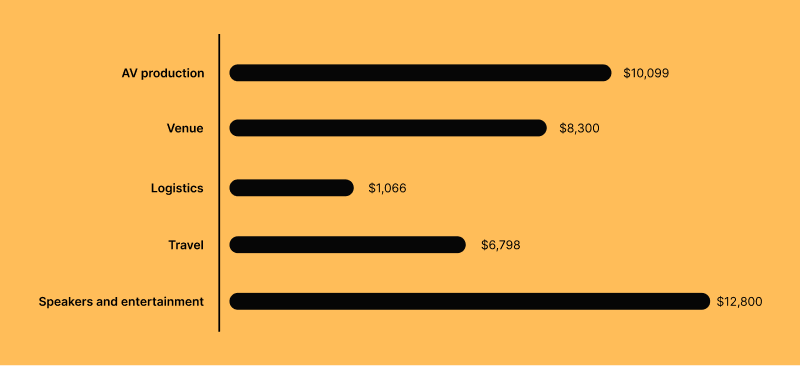
🎤 AV production - $10,099
- In-person: mics, speakers, screens, etc.
- Virtual: wifi, recording equipment, a device to view attendee responses from, etc.
🏢 Venue - $8,300
- In-person: physical venue, F&B
- Virtual: event platform
👩💻 Logistics - $1,066
- In-person: staff to manage things on the ground, signage, badges
- Virtual: staff to support and moderate online
🚗 Travel - $6,798
🥳 Speakers and entertainment - $12,800
As any modern event marketer can tell you, it’s tough to accurately predict in-person attendance. Out of 130 in-person registrants, the event had 41 attendees for a 32% in-person show-rate. Keep in mind—this was a free event. Paid events likely have a much higher show-rate, but that’s a different conversation for a different day.
And thanks to the additional 85 virtual attendees, the cost per acquisition came down considerably to be comparable to other marketing channels.
Making hybrid happen — what we've learned so far
Though we had the right budget and mindset going in, there were still some unexpected lessons to be learned from our first hybrid event.
Here are our biggest learnings so far.
The dos 👍🏽
While many hybrid events force virtual attendees to engage via the host or moderator, we succeeded in finding simple but powerful ways to remove the barriers between audiences and create a shared networking experience.
- Bring folks together with shared chat: Enable the virtual chat so that both in-person and digital attendees can network, swap battle stories, and send out the occasional GIF in response to what they’re learning.
- Offer a truly hybrid Q+A: Give in-person attendees the option to raise their hand or type a question in via your virtual chat or Q&A. Video Q&A is another great way to welcome virtual attendees ‘on stage’ to ask their questions.
- Provide entertainment: As the in-person attendees arrived and found their seats, DJ Toasty took song requests from the virtual audience, which helped set a fun group vibe for everyone.
The don’ts 👎🏼
With the additional planning that goes into a hybrid event, it can be tough to know where to focus your efforts. Here are the areas where we think we could have done better.
- Don’t forget about swag: Our in-person attendees received swag gifts, but virtual attendees didn’t. This was a missed opportunity that should have been (and could have been) a shared hybrid experience.
- Don’t let it get awkward: Some think tank discussions where groups had topics to debate post-panel were a success. Others were more invested in networking. Next time, we’ll plan to allocate moderators for each group to keep discussions on track.
- Don’t skip on signage: While we had some banners for our in-person attendees, we could have used one or two more to keep folks from getting lost.
Three more tips to win with hybrid events
- Choose the right format: Base your hybrid event format on both the content you’re sharing and the audience you’re sharing it with. Meet people where they are and don’t force in-person on those who simply aren’t ready for it.
- Get picky with your partners: Consider which partners have the highest return on investment and can cater to both in-person and virtual attendees easily.
- Consider quality over quantity: Ask yourself: ‘What can we stop doing, what can we do more of, and how can we be more targeted in our approach to hybrid events?’
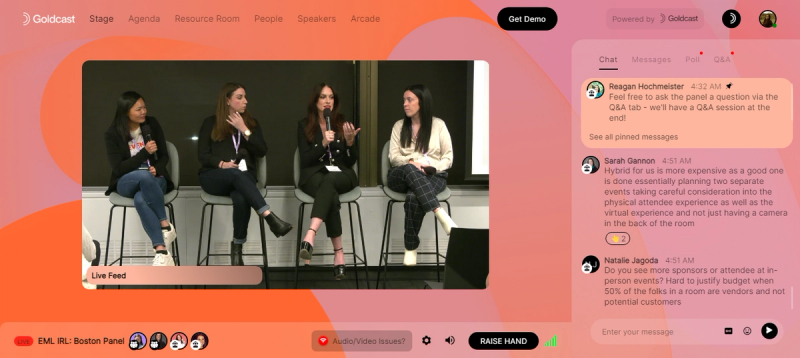
Other helpful hybrid event resources
Like you, we’re learning as we go.
If you’re looking for more resources on how to win with hybrid, here are some of our top guides, articles, and events so far.
- A guide to hybrid event formats
- Insider insights from event expert Lisa Gregory
- A deep dive on the benefits of hybrid events
- How top event marketers are thinking about hybrid
- A (mostly objective) guide to choosing a hybrid platform
- Preparation steps when pivoting from virtual to hybrid events
- Real conversations via the Event Marketers Live and CMO diaries event series
- Case studies from real brands crushing it with digital events
You decide what’s next for hybrid
As fellow event marketing evangelists, we’re here for both the joys and struggles that hybrid events can bring.
Because the truth is, hybrid events are no longer optional. Brands that want to win with event marketing must embrace this new format. And while running a successful hybrid event does take work, the latest attendee data indicates that the benefits will be well worth it in the long term.
Whatever hybrid entry method you choose, we’ll be right here to cheer you on, back you up, and help make hybrid happen.

Stay In Touch
Platform
Resources
Company
Community
© 2025 Copyright Goldcast, Inc. All rights reserved.



 Upcoming Events
Upcoming Events Event Series
Event Series On-Demand Events
On-Demand Events

